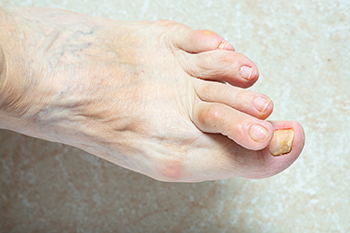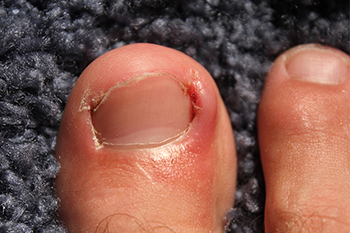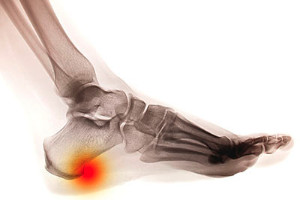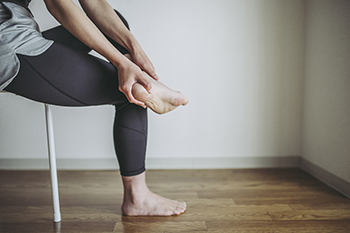Items filtered by date: November 2023
Types of Hammertoe Surgery

Hammertoe is a condition where the second, third, or fourth toe bends at the joint due to muscle or ligament imbalance, often caused by factors like injury, wearing poor footwear, or arthritis. Surgery can be an option for severe cases causing pain or balance issues, but it may not be suitable for those with poor circulation, increased surgery risks, or infections. Successful treatment depends on the severity of the hammertoe. Options may include tendon transfer, joint resection, or fusion, with the latter two involving cutting tendons and ligaments to straighten the toe. Tendon transfer reroutes tendons to straighten the toe, while joint resection and fusion involve bone alterations and the use of pins or screws. If you have a hammertoe and it is causing discomfort, it is suggested that you schedule an appointment with a podiatrist to discuss whether surgery is an option for you.
Hammertoe
Hammertoes can be a painful condition to live with. For more information, contact Patrick Bruton, DPM from Big Country foot and Ankle. Our doctor will answer any of your foot- and ankle-related questions.
Hammertoe is a foot deformity that affects the joints of the second, third, fourth, or fifth toes of your feet. It is a painful foot condition in which these toes curl and arch up, which can often lead to pain when wearing footwear.
Symptoms
- Pain in the affected toes
- Development of corns or calluses due to friction
- Inflammation
- Redness
- Contracture of the toes
Causes
Genetics – People who are genetically predisposed to hammertoe are often more susceptible
Arthritis – Because arthritis affects the joints in your toes, further deformities stemming from arthritis can occur
Trauma – Direct trauma to the toes could potentially lead to hammertoe
Ill-fitting shoes – Undue pressure on the front of the toes from ill-fitting shoes can potentially lead to the development of hammertoe
Treatment
Orthotics – Custom made inserts can be used to help relieve pressure placed on the toes and therefore relieve some of the pain associated with it
Medications – Oral medications such as anti-inflammatories or NSAIDs could be used to treat the pain and inflammation hammertoes causes. Injections of corticosteroids are also sometimes used
Surgery – In more severe cases where the hammertoes have become more rigid, foot surgery is a potential option
If you have any questions please contact our offices located in Abilene, and Brownwood, TX . We offer the newest diagnostic and treatment technologies for all your foot and ankle needs.
How to Prevent Ingrown Toenails

Ingrown toenails can be a painful and bothersome foot condition, but they are often preventable with proper care and understanding of their causes. This troublesome malady occurs when the edge or corner of a toenail grows into the surrounding skin, leading to pain, redness, and potential infection. One common cause of ingrown toenails is improper nail trimming. Cutting the nails too short or rounding the edges can encourage the nail to grow into the skin. Wearing tight or ill-fitting shoes that put pressure on the toes is another contributing factor, as it can force the nail to grow abnormally. To prevent ingrown toenails, it is important to trim the nails straight across and not too short. Wearing well-fitted, comfortable shoes that can provide enough room for your toes may also help to prevent this painful condition. Additionally, maintaining good foot hygiene and protecting your toes can go a long way in preventing the development of ingrown toenails. If you have developed this ailment, it is strongly suggested that you schedule an appointment with a podiatrist as quickly as possible who can offer treatment options that are right for you.
Ingrown toenails may initially present themselves as a minor discomfort, but they may progress into an infection in the skin without proper treatment. For more information about ingrown toenails, contact Patrick Bruton, DPM of Big Country foot and Ankle. Our doctor can provide the care you need to keep you pain-free and on your feet.
Ingrown Toenails
Ingrown toenails are caused when the corner or side of a toenail grows into the soft flesh surrounding it. They often result in redness, swelling, pain, and in some cases, infection. This condition typically affects the big toe and may recur if it is not treated properly.
Causes
- Improper toenail trimming
- Genetics
- Improper shoe fitting
- Injury from pedicures or nail picking
- Abnormal gait
- Poor hygiene
You are more likely to develop an ingrown toenail if you are obese, have diabetes, arthritis, or have any fungal infection in your nails. Additionally, people who have foot or toe deformities are at a higher risk of developing an ingrown toenail.
Symptoms
Some symptoms of ingrown toenails are redness, swelling, and pain. In rare cases, there may be a yellowish drainage coming from the nail.
Treatment
Ignoring an ingrown toenail can have serious complications. Infections of the nail border can progress to a deeper soft-tissue infection, which can then turn into a bone infection. You should always speak with your podiatrist if you suspect you have an ingrown toenail, especially if you have diabetes or poor circulation.
If you have any questions, please feel free to contact our offices located in Abilene, and Brownwood, TX . We offer the newest diagnostic and treatment technologies for all your foot care needs.
A Comprehensive Overview of Heel Spurs

Heel spurs, a common foot condition, are bony outgrowths that form on the underside of the heel bone. They often develop in response to long-term strain on the foot's ligaments and muscles. While many individuals have heel spurs, not all experience pain. When pain does occur, it is generally due to the inflammation of the surrounding tissues, a condition known as plantar fasciitis. The symptoms of heel spurs can include sharp, stabbing pain in the heel, especially while walking or standing after periods of rest. The pain tends to improve as the foot warms up but may return after prolonged activity. Risk factors for heel spurs include obesity, wearing poor-fitting or worn-out shoes, and activities that place excessive strain on the feet, such as running and prolonged standing. Diagnosis and treatment may involve having X-rays taken to confirm the presence of a heel spur. Understanding heel spurs and their management options is vital for individuals seeking relief from this often painful condition. If you have developed a heel spur, it is suggested that you consult a podiatrist who can determine if it is mild or severe, and offer treatment options that are right for you.
Heel spurs can be incredibly painful and sometimes may make you unable to participate in physical activities. To get medical care for your heel spurs, contact Patrick Bruton, DPM from Big Country foot and Ankle. Our doctor will do everything possible to treat your condition.
Heels Spurs
Heel spurs are formed by calcium deposits on the back of the foot where the heel is. This can also be caused by small fragments of bone breaking off one section of the foot, attaching onto the back of the foot. Heel spurs can also be bone growth on the back of the foot and may grow in the direction of the arch of the foot.
Older individuals usually suffer from heel spurs and pain sometimes intensifies with age. One of the main condition's spurs are related to is plantar fasciitis.
Pain
The pain associated with spurs is often because of weight placed on the feet. When someone is walking, their entire weight is concentrated on the feet. Bone spurs then have the tendency to affect other bones and tissues around the foot. As the pain continues, the feet will become tender and sensitive over time.
Treatments
There are many ways to treat heel spurs. If one is suffering from heel spurs in conjunction with pain, there are several methods for healing. Medication, surgery, and herbal care are some options.
If you have any questions feel free to contact our offices located in Abilene, and Brownwood, TX . We offer the latest in diagnostic and treatment technology to meet your needs.
Unraveling the Mysteries Behind the Agony of Heel Pain

Heel pain is a common grievance that can impact people of all ages and lifestyles. To understand why it afflicts so many, it is essential to delve into its multifaceted causes. One of the primary culprits is plantar fasciitis, where the tissue connecting the heel to the toes becomes inflamed due to excessive strain, often stemming from prolonged standing, or from wearing improper footwear. Another common source of heel pain is Achilles tendonitis, an overuse injury affecting the tendon at the back of the heel, which can result from intense physical activities and inadequate rest. Heel spurs, small calcium deposits on the heel bone, can also trigger discomfort, often linked to conditions like plantar fasciitis. Additionally, various systemic diseases, such as arthritis, can manifest as heel pain. If you have heel pain for any reason, it is suggested that you visit a podiatrist who can determine what that cause is, and offer treatment options that are right for you.
Many people suffer from bouts of heel pain. For more information, contact Patrick Bruton, DPM of Big Country foot and Ankle. Our doctor can provide the care you need to keep you pain-free and on your feet.
Causes of Heel Pain
Heel pain is often associated with plantar fasciitis. The plantar fascia is a band of tissues that extends along the bottom of the foot. A rip or tear in this ligament can cause inflammation of the tissue.
Achilles tendonitis is another cause of heel pain. Inflammation of the Achilles tendon will cause pain from fractures and muscle tearing. Lack of flexibility is also another symptom.
Heel spurs are another cause of pain. When the tissues of the plantar fascia undergo a great deal of stress, it can lead to ligament separation from the heel bone, causing heel spurs.
Why Might Heel Pain Occur?
- Wearing ill-fitting shoes
- Wearing non-supportive shoes
- Weight change
- Excessive running
Treatments
Heel pain should be treated as soon as possible for immediate results. Keeping your feet in a stress-free environment will help. If you suffer from Achilles tendonitis or plantar fasciitis, applying ice will reduce the swelling. Stretching before an exercise like running will help the muscles. Using all these tips will help make heel pain a condition of the past.
If you have any questions please contact our offices located in Abilene, and Brownwood, TX . We offer the newest diagnostic and treatment technologies for all your foot and ankle needs.

